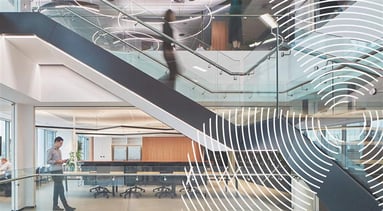
As we navigate the post-COVID workplace in real time with our clients, we’re keeping a pulse on their workplace requirements and biggest challenges, to understand their perspectives and deliver a tailored solution for their needs. We share our learnings Unispace Pulse of the Workplace Market Study, which surveyed real estate decision makers from nearly 150 companies with office footprints worldwide.
While it’s clear that things are beginning to pick up for companies across the globe – albeit with some interesting regional nuances – our survey highlights several roadblocks to getting people back into the office, from making employees feel safe at work to managing different needs across different geographies.
More than half (52%) of companies surveyed globally anticipate a ‘return to a new normal’ by the end of Q3 2021. Yet, more than one third (35%) claim that devising a strategy for the future workplace is the most significant barrier to realizing this new reality.
What’s notable about these roadblocks is that they all tie back to the issue of strategy. Companies understand that the future involves hybrid working, but they can’t always see how this concept translates into a day-to-day operational reality.
Our top findings:
Globally, more than half of responding companies anticipate a material ‘return to new normal’ by end of Q3. The Americas region remains the least optimistic about returning to the office in the near term.
The majority of companies are rethinking their workplace. Nearly 75% of employers responding anticipate launching new workplace projects by the end of 2021.
A shift toward hybrid working and smaller physical office environments continues to dominate organizational thinking about real estate in 2021. Just 16% of respondents globally expect to proceed with major projects of 50,000 sq. ft or upwards.
Respondents’ biggest ‘pain point’ when considering ‘return to new normal’ is workplace strategy. This comes ahead of additional cited challenges including employee safety, varied geographic needs, space configuration, and timing.
Return to office timings differ across the regions
Every region is experiencing the pandemic differently, leading to different expectations about what the new normal may hold and when we’ll get there. For example, while more than half of companies expect the new normal to be upon us by the end of Q3, this figure is significantly higher in APAC (71%) compared to the Americas (43%).
While optimism levels appear to be lower across the Americas, four out of five companies believe that they will be back in the physical office by the close of 2021, explaining why nearly three quarters (74%) are planning to embark on new workplace design projects before the end of the year.
And despite the regional variances, there is at least one area of consensus. When it comes to the physical workplace, all companies recognize that the new normal will be different to the old.
Reconfiguration is taking priority
30% of companies are looking to develop new spaces or completely reimagine their existing environments. For the most part, however, our respondents are focused on reworking and reconfiguring their current offices to support post-Covid ways of working. Almost half (48%) of companies see medium scope reconfiguration projects as their priority, with a further 22% citing only the need for light reworking projects.
EMEA is driving demand for new workplaces (45% of companies), whereas, across the Americas, this is a priority for just 20% of companies, with 57% looking instead at reconfiguration projects.
Smaller is in style
We’re seeing the most pressing need for new workplace projects in EMEA, where 48% of companies claim smaller-scale work (under 20,000 sq. ft.) will be necessary before the end of June 2021.
In contrast, more than half (54%) of APAC firms anticipate larger projects of between 20,000-50,000 sq. ft. but more evenly spread across the year.
Interestingly, just 16% of companies globally expect to proceed with major projects of 50,000 sq. ft or upwards. It’s another sign of a shift towards smaller physical office environments that is occurring as more companies pivot towards hybrid working, with employees carrying out focus work from home and heading into the office for collaboration, socialization and strategic work.
Solving strategic challenges with predictive analytics
Perhaps the key insight from our survey is that more than one third of companies are struggling to align their return to office strategies with their workplace projects. This can be distilled down to two considerations: how much space is needed and how is going to be used?
Unless these considerations are worked through in full, companies run the risk of over-reduction, leaving no room for employees with a genuine need to be in the office. This is where space utilization data and predictive analytics can be instrumental in unlocking strategic insights about how the post-Covid workplace will function – from basic occupancy levels to real-time analysis of in-office footfall and employee behaviors.
Aside from these strategic challenges, the other main pain points companies are facing with the return to office plans are managing the needs of different geographies (17%) and establishing effective ways to make employees feel safe in the office (16%).
In Auckland, where we’ve completed our first built example of the post-Covid workplace, we’re able to track every aspect of our team’s office utilization in real-time. The data is not only helping us to establish effective working patterns and keep everyone safe in our Auckland studio; it’s informing our global strategy for returning to the new normal – a strategy based on employees’ actual needs and behaviors, rather than guesswork and speculation.
Easing the transition to the new normal
When solving strategic workplace challenges in an uncertain climate, it often helps to seek out an unbiased third-party perspective on what needs to happen, and when.
This is why we’re having as many conversations as we can across our global client base to help companies establish their workplace portfolio needs before the return to the office gathers pace.
Click here to view the market insights.
If you’d like to learn more about our thinking for the post-Covid workplace, read our Propeller Framework for making hybrid working a reality, or check out the Unispace Auckland case study for a flavor of what Propeller looks like in action.


